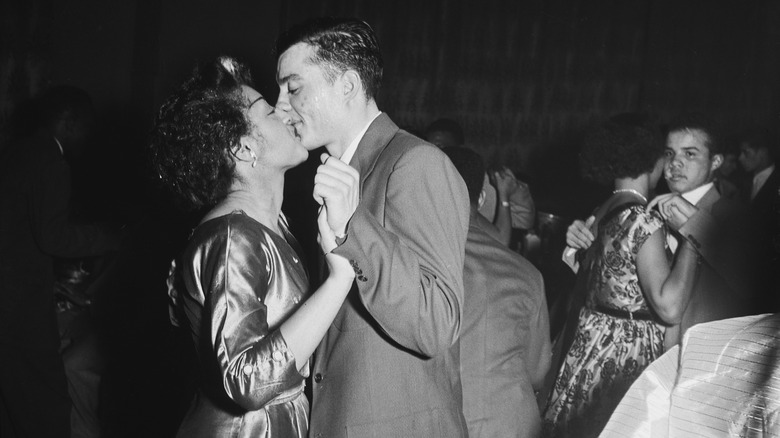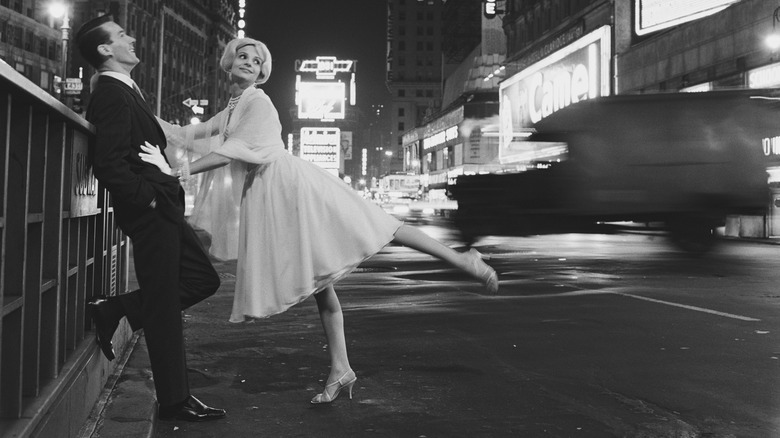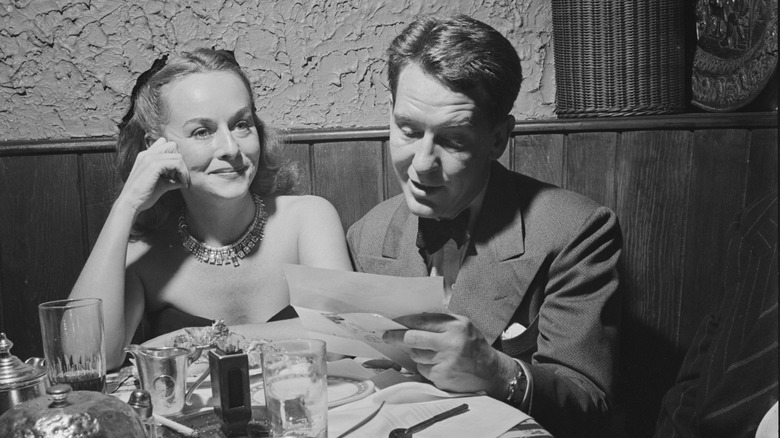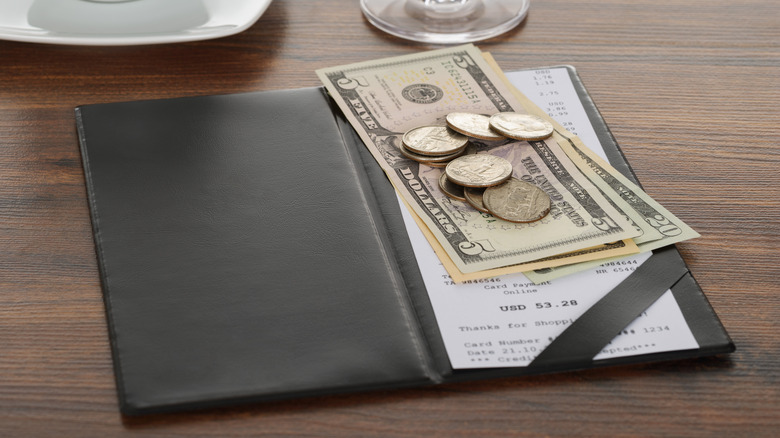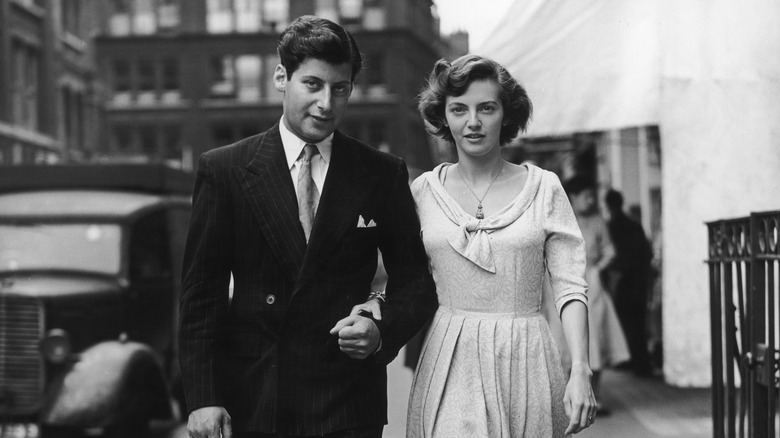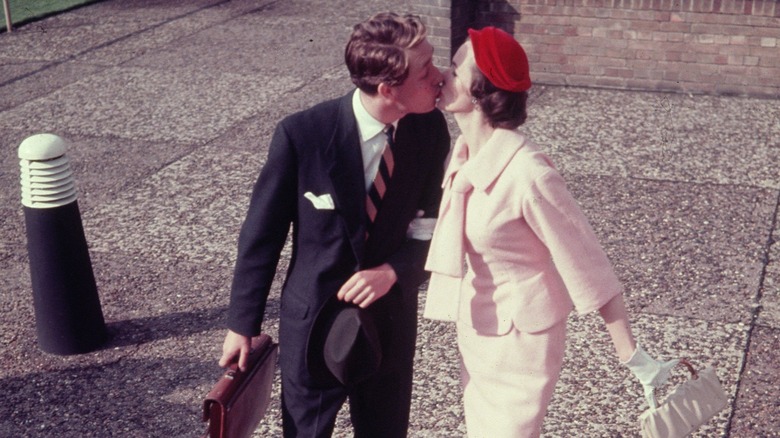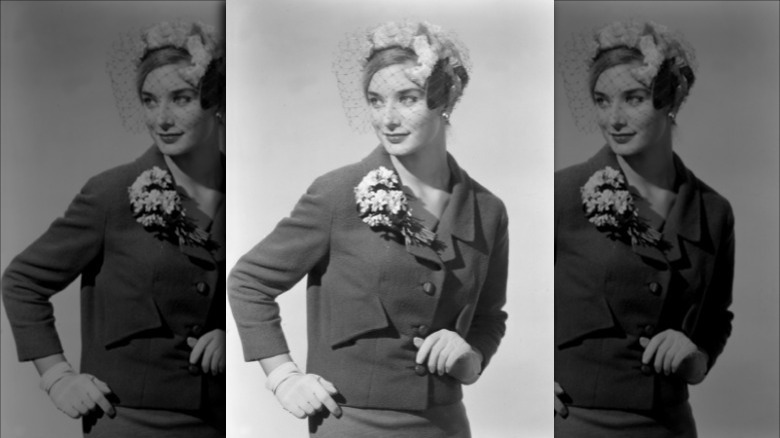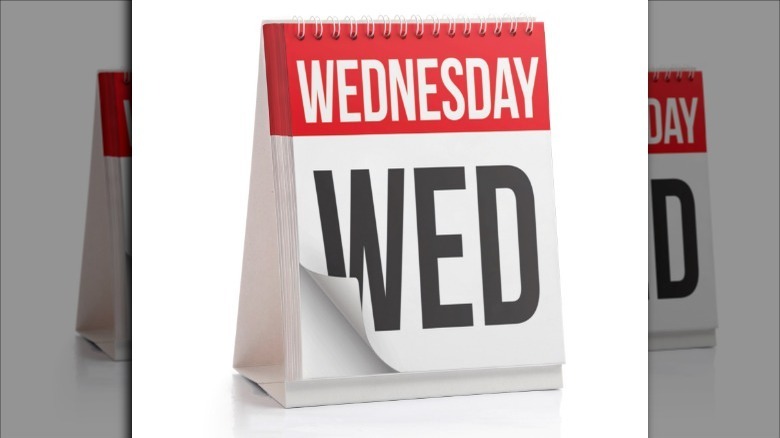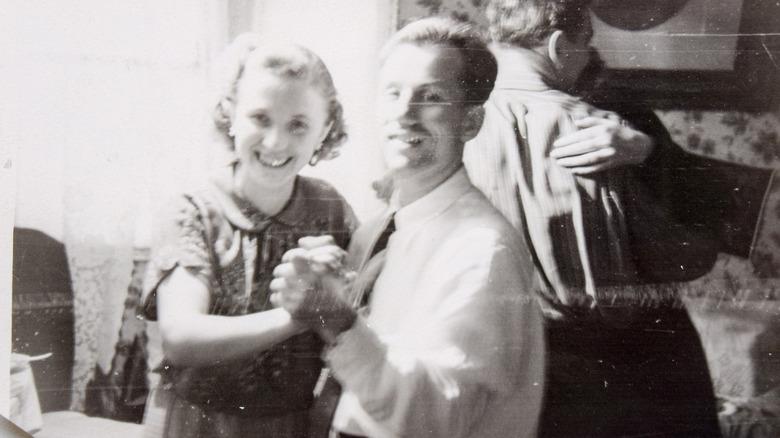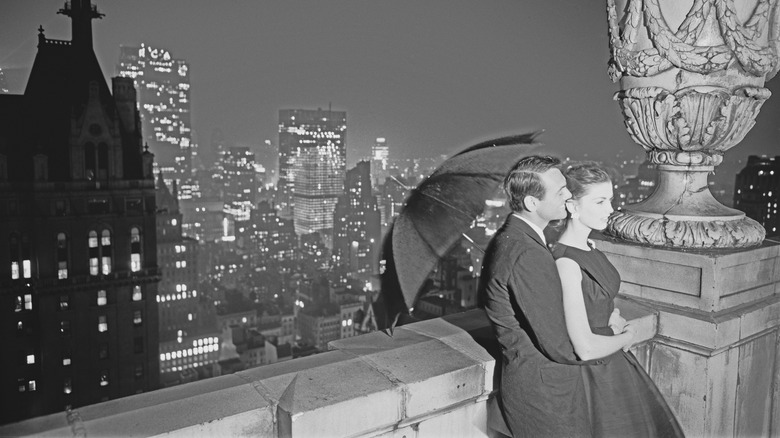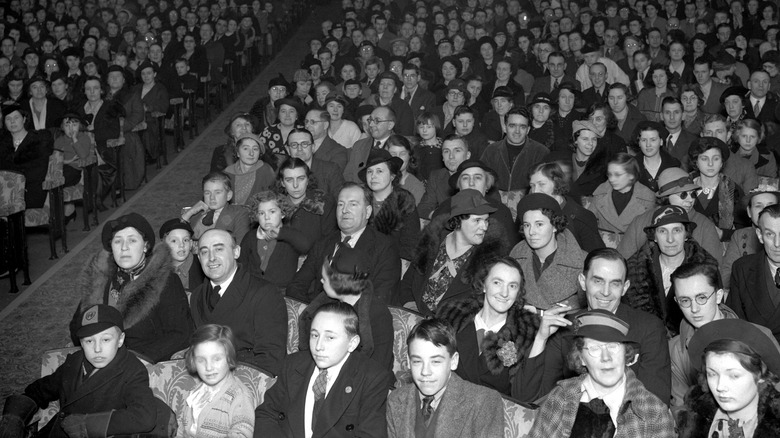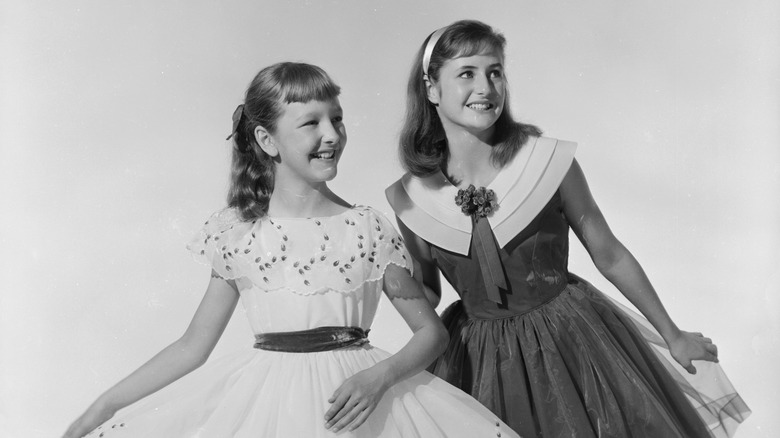Outdated Dating Etiquette Rules From The 1950s
Pop culture and modern media have a distorting effect on our collective concept of time. A great example of this distortion is the 1950s — a decade that is now more than 70 years in our past, and yet seems much more recent because of its hold on the popular imagination. Thanks to TV shows like "Happy Days" and films like 2021's "West Side Story" remake, everyone feels familiar with the 1950s in ways that folks in the 1920s didn't feel about the 1850s.
Seven decades is a long time. America in the 1950s was vastly different than it is today in just about every way. From demographics to the economy, culture, music, and our diets, the Americans of the 1950s might as well be citizens of a foreign country. But the 1950s were modern enough to leave behind anthropological evidence of its weirdness. As Southern Living Magazine notes, people actually published stuff like "dating etiquette" guides for teens and young adults in the 1950s. The idea that horny teenagers would sit down for a few hours and study up on how to date seems ludicrous in the "send nudes" age of dating, but it does give us a glimpse into the alien way dating and romance was treated back in those days.
As you might imagine, the ideas in these sorts of guides are seriously antiquated — and often hilarious. Here are some of the most outdated dating etiquette rules from the 1950s.
Only guys should initiate a date
As noted by The Little Things, a lot of the rules of dating etiquette in the 1950s might seem a bit square today — but they did have the effect of encouraging civility, good manners, and a certain level of mindfulness. In an age of absolutely savage digital dating where everything from your height to the speed of your text responses can lead to heavy verbal abuse, that almost sounds refreshing.
And then there are the flat-out sexist rules, like one of the least surprising rules to come out of the 1950s: Boys were supposed to ask out girls, never the other way around (it should go without saying that the dating rulebooks of the 1950s did not include any helpful references for queer, nonbinary, or trans folks trying to find love).
As noted by Southern Living Magazine, behind the superficial chivalry of leaving the asking out to boys is the implication that any girl who would dare ask out a boy is, er, fast. Which is to say there is a lot of shaming in these old dating rules, as girls were supposed to be pursued. A lot of this wasn't explicit — the rule books didn't say "don't be easy." They used coded language about aggressiveness being unattractive. What's really funny is the confidence with which it's assumed that men don't like to be asked out, which is pretty much one hundred percent untrue.
Introduce dates to your parents on a first date
Some things never change, and introducing a special friend to your parents remains a pretty big deal in the 21st century. While the guidelines on when that's appropriate continue to evolve, the fact remains that if you bring someone home to the 'rents you're basically saying they may be there for the long haul, whatever that means to you.
And that was true in the 1950s, with one twist: As explained by CBC Life, in the book "Teen Guide to Homemaking," if you were a girl going on a first date with a boy, the boy was expected to pick you up from home — and meet your parents for inspection (via The Little Things). This obviously stems from two fundamentally sexist concepts — one, that a young girl is incapable of judging the character of a dreamy boy, and two, that dreamy boys have to be approved by stern fathers before being granted access to their daughters. It's the same principle that fuels the tradition of fathers giving away brides at weddings — a symbolic transfer of property (via Insider).
As noted by Best Life, a different aspect of this (not so much a rule as a simple fact of life) was calling someone on the phone. Back in the 1950s, homes typically had one phone. Private lines for teenagers weren't exactly universal — so chances were if you called up your crush you'd have to get past their parents, first.
The man should order dinner — for both of you
If you're a woman who knows what you want and orders meals like Sally Albright, you might have struggled a bit in the 1950s dating scene. As noted by Reader's Digest, the rules required you to tell your date what you wanted and let him order it for you. In a way, you should be grateful you even got the opportunity to express an opinion.
On the surface, this might look like simple sexism — and, yes, it sure it. But as noted by The Little Things there was some actual cultural weight behind the requirement. In the 1950s, a date was viewed as a social event, and the man was regarded as the 'host.' In the same way a party host might bring your a drink or a plate of food without asking, the man was expected to take care of everything. That means going around your date to order your own meal would have been seen as rude — and as a negative comment on his hosting-cum-dating skills.
Today, of course, if a man insists on ordering for his date he might think it makes him look suave and confident — and some women might find it charming. But as Salon notes, it usually has his date texting "911" to their friends. The rules are also silent as to whether the man should also eat both meals in a display of dominance.
The man always pays
Another very obvious 1950s attitude toward dating is who pays — according to Reader's Digest, that would be the man, of course. In fact, Southern Living Magazine notes that men who are happy to let their dates pay for their meals are "grafters" or have no pride. Which begs the question of whether there were hordes of lazy men soaking up free meals from women desperate for dates back in the 1950s.
Although The Little Things notes that men would find their date offering to pay for the date "emasculating," the question of splitting the bill or "going Dutch" isn't so clear-cut. Some dating guides from the 1950s indicate that splitting the bill is perfectly fine as long as both participants agree ahead of time. But as noted by Her Campus, some guides expected the man to pay for the whole date and indicate that splitting the bill would have been unthinkable. Of course, the average date in 1959 apparently cost $7 (about $67 today). The times, of course, have changed — a study by Affirm notes that 68 percent of modern daters expect to at least get an offer to split the bill on a first date.
The man should always walk between his date and the curb
According to Reader's Digest, in the 1950s when a man and a woman walked on the street during a date, the man was expected to walk on the street side at all times. While this might imply that the 1950s were a dangerous decade in which women were routinely snatched off the sidewalks, the reasons behind this antiquated "rule" aren't quite so negative.
According to historian Baltasar Gracián in the book "The Etiquette Collection," the practice dates back to pre-automobile days. Walking on the curb side of a street exposed you to splashes from passing carriages, and gentlemen were expected to protect the lady's fancy clothes by walking on the left side. Splashing from passing cars is just as damaging to clothes, of course, but in the modern day most people agree that the men deserve just as much consideration.
On the other hand, the Belleville News-Democrat suggests that back in the days when men routinely wore swords, having the lady (in her presumably voluminous skirts) walking on his left side meant his sheath might get caught up in her dress. Alternatively, having his right side unencumbered allowed him to draw his weapon easily without having to rudely shove his date out of the way.
No kissing on first date
This one might not surprise anyone: According to The Little Things, a big rule of 1950s courtship was no kissing on the first date. Of course, teenagers have been raging hormone machines since the beginning of time, so it seems like this rule was regarded as more of a guideline. As noted by Best Life, one reason so much of a couple's dating life revolved around the automobile was the privacy and mobility it offered couples: They could drive someplace remote and make out (or more) to their heart's content.
As noted by Southern Living Magazine, in his books "For Girls Only" and "For Boys Only," Frank Howard Richardson uses shame to prevent getting busy. "I hate to say it," the good doctor mourns, "but it's not always the boy who is the one that suggests going out to the car. All too often it is the girl." Typically, Richardson ties being chaste with respect, advising girls that boys won't respect them if they give in to "petting." His advice to boys is a lot more practical, noting that getting physical might lead to going farther than intended. Instead of warning about respect, he simply admonishes boys to "watch your step!"
Bring a corsage
In the modern day, the corsage is typically only seen on prom nights and is regarded as a charmingly hokey tradition. But according to The Daily Meal, back in the 1950s the man was expected to show up on a first date with flowers in hand — and as noted by Reader's Digest, the corsage was absolutely required for proms.
This wasn't just quaint romantic tradition, though. As noted in the book "From Front Porch to Back Seat: Courtship in Twentieth-Century America," flowers and corsages were symbols of affluence and consumption in the mid-20th century. The 1950s was a consumerist, materialistic decade as the economy boomed post-war, and the rules of dating weren't immune to that. According to PBS, in fact, being an avid consumer was considered patriotic at the time because you were doing your part to support the American economy. Men purchased expensive flowers to prove they could afford to do so, and women wore or carried them ostentatiously so everyone would know their date was a man of means. In fact, flowers became overt status symbols — girls wanted orchids in part because they were so expensive — about $5 per flower, which would be more than $50 today.
Wednesday was the deadline
Today, dating is pretty casual. A date can be anything from meeting up for coffee to something elaborate and expensive. And just about any day of the week is appropriate for a first date — in fact, sometimes a week night is best because it comes with work as the built-in excuse to end things early. But according to The Little Things, back in the 1950s, dating rules required you to be a little more organized. The guy was expected to ask a girl out no later than Wednesday if he expected her to be his date on Friday.
In some ways this is just basic courtesy, and even today it's an unspoken rule that last-minute plans will always make people feel like your real plans fell through. But as noted in The Tower, this was also part of a focus on communication and punctuality — plus the assumption that women would, naturally, need several days to prepare for their momentous date with the man of their dreams.
But there was another aspect to this rule. According to the book "From Front Porch to Back Seat: Courtship in Twentieth-Century America," the need for advance notice went back to earlier decades. Women on college campuses required a lot of advance notice for dates in order to build up the appearance of popularity and exclusivity. In other words, agreeing to a last-minute date made you look desperate.
Steadies exchanged gifts
Believe it or not, "going steady" — meaning you dated one person exclusively — was something of a new concept in the 1950s. It was also a surprisingly controversial one. While you might assume that parents would be delighted that their kids were settling into a monogamous relationship, according to Time, the opposite was true. People were worried that teenagers should be dating around and experiencing more relationships in order to broaden their horizons. Even the Catholic Church condemned the practice, possibly because going steady indicated getting more ... comfortable with each other's bodies.
In fact, going steady was actually the rebellious thing to do in some ways, and dating couples were expected to give each other small gifts to mark each other as taken. As noted by Today, "getting pinned" was part of the whole courtship ritual, and it involved literal fraternity pins or class rings (according to Best Life). Authors William H. Young and Nancy K. Young note in their book "The 1950s" that an industry of cheap "friendship rings" grew up to supply couples with tokens to give each other, and other things like bracelet charms or matching articles of clothing were used.
While the exchange of tokens like this might seem antiquated, according to the book "Youth and Sexuality in the Twentieth-Century United States," the practice continued to be popular up until the 1980s.
The boy should have a plan
The question of what to do on a date remains a pretty thorny one. Before you know the other person well it can be tough to figure out what they'd enjoy doing. For that reason a lot of early dates center on universal activities like eating dinner.
But today, at least dates can be planned together so no one winds up forced to do something they hate. But as noted by The Art of Manliness, in the 1950s, one of the rules was that the man makes all the plans. An old instructional film called "What to Do on a Date" from the 1950s depicts a clueless young fellow struggling to date the girl he likes under the guidance of his friend. It's made pretty clear that one of his biggest blunders is actually asking his crush what she'd prefer to do instead of simply presenting her with a confident plan.
This obviously conforms to traditional gender roles, with the man in charge so the woman can simply enjoy herself. As noted by Her Campus, women were advised in the 1950s that being too self-reliant might actually ruin their relationships. They were urged to let the man take the lead in all things in order to conform to gender roles.
No PDA in movie theaters
If it seems like the 1950s were obsessed with sex, that's not entirely wrong. This wasn't just weird conservative views, however — there were real reasons people were worried about all the youngsters getting frisky on their dates. For one thing, as noted by US News, after World War II people began to get married a lot younger than they had before. In fact, in the 1950s and 1960s people got hitched younger than just about any other time in our history. According to the book "The 1950s," most women were married by age 19 in the 1950s.
This had a ripple effect — dating had to start earlier if people were going to find their spouses earlier. As a result, teenagers began their romantic lives far earlier than they had before, which made parents worry that they were exploring their sexuality before they were ready for it. This led directly to weird stuff like patrols organized to check that people on dates weren't making out in their cars (per The Little Things). And as noted by CBC Life, this attitude also inspired some weird dating rules, like never showing physical affection in a movie theater — a popular place for such shenanigans for obvious reasons.
Girls shouldn't be themselves
One of the most horrifying rules of dating from the 1950s involved how a girl should interact with their date. Southern Living Magazine notes that in Frank Howard Richardson's book "For Girls Only" he literally advises girls to "fool" their boy friends by feigning an interest in his hobbies. Essentially, the good doctor anticipated Taylor Swift's song "Blank Space," in which she describes her dating strategy as "find out what you want / be that girl for a month."
Of course, that's kind of sociopathic, but Dr. Richardson is confident that the girl in question will learn to be just as excited by her man's hobby as he is. In other words, she will slowly change in order to please the guy she's dating, which seems like a solid plan for lifelong happiness. This wasn't isolated advice, either. A 1958 article in McCall's Magazine titled "129 Ways to Get a Husband" (via Bored Panda) also advises ladies to learn how to clean fish or play poker in order to impress their date (whether they enjoy it or not).
Of course, the idea that being yourself and expressing your actual feelings towards hobbies or date activities (McCall's also advises that "if he decides to skip the dance and go rowing on the lake, go — even if you are wearing your best evening gown") is against the dating "rules" is pretty unhealthy — and one rule that should be broken.
